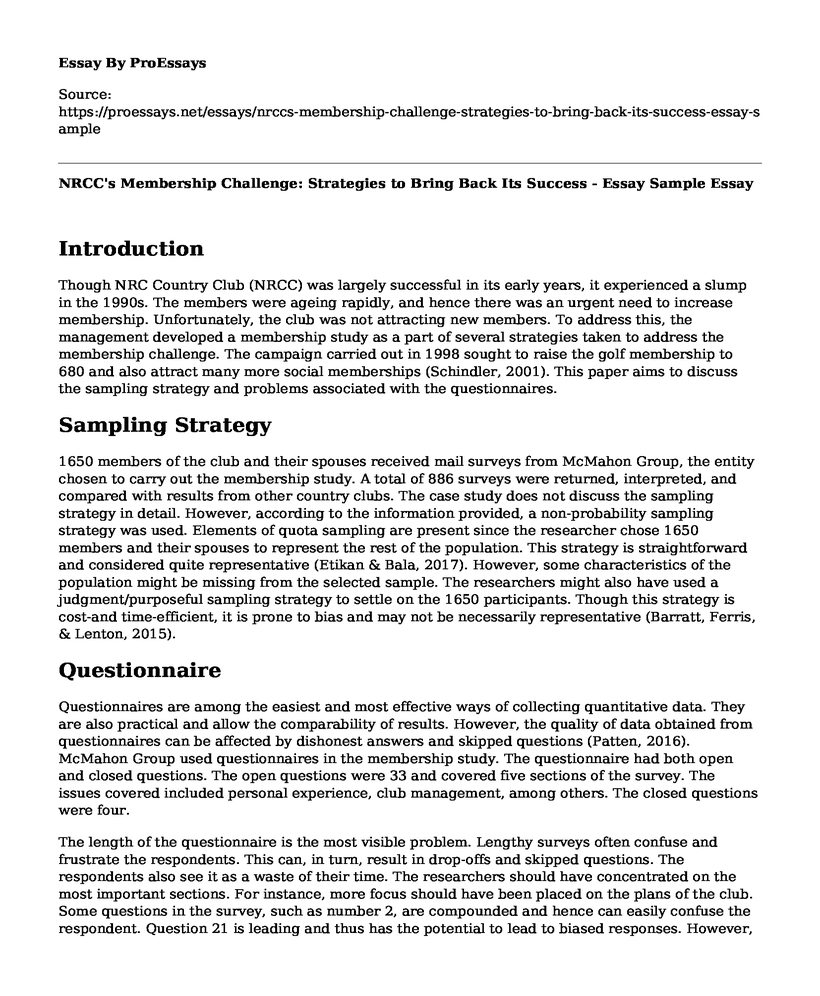Introduction
Though NRC Country Club (NRCC) was largely successful in its early years, it experienced a slump in the 1990s. The members were ageing rapidly, and hence there was an urgent need to increase membership. Unfortunately, the club was not attracting new members. To address this, the management developed a membership study as a part of several strategies taken to address the membership challenge. The campaign carried out in 1998 sought to raise the golf membership to 680 and also attract many more social memberships (Schindler, 2001). This paper aims to discuss the sampling strategy and problems associated with the questionnaires.
Sampling Strategy
1650 members of the club and their spouses received mail surveys from McMahon Group, the entity chosen to carry out the membership study. A total of 886 surveys were returned, interpreted, and compared with results from other country clubs. The case study does not discuss the sampling strategy in detail. However, according to the information provided, a non-probability sampling strategy was used. Elements of quota sampling are present since the researcher chose 1650 members and their spouses to represent the rest of the population. This strategy is straightforward and considered quite representative (Etikan & Bala, 2017). However, some characteristics of the population might be missing from the selected sample. The researchers might also have used a judgment/purposeful sampling strategy to settle on the 1650 participants. Though this strategy is cost-and time-efficient, it is prone to bias and may not be necessarily representative (Barratt, Ferris, & Lenton, 2015).
Questionnaire
Questionnaires are among the easiest and most effective ways of collecting quantitative data. They are also practical and allow the comparability of results. However, the quality of data obtained from questionnaires can be affected by dishonest answers and skipped questions (Patten, 2016). McMahon Group used questionnaires in the membership study. The questionnaire had both open and closed questions. The open questions were 33 and covered five sections of the survey. The issues covered included personal experience, club management, among others. The closed questions were four.
The length of the questionnaire is the most visible problem. Lengthy surveys often confuse and frustrate the respondents. This can, in turn, result in drop-offs and skipped questions. The respondents also see it as a waste of their time. The researchers should have concentrated on the most important sections. For instance, more focus should have been placed on the plans of the club. Some questions in the survey, such as number 2, are compounded and hence can easily confuse the respondent. Question 21 is leading and thus has the potential to lead to biased responses. However, regardless of these problems, the questionnaire is generally well designed, and its effectiveness assured. The questions are complete and sensitive to the different demographics making up the club membership. The open-ended questions used are also few, a factor that makes it easy to analyze the findings.
Conclusion
The membership study initiated by NRCC and carried out by McMahon Group used a non-probable sampling strategy and employed questionnaires. Though the methodologies carry various disadvantages, the study was largely effective. The sampling strategy used helped achieve higher representation while the use of questionnaires allowed the researchers to collect more information from the respondents. Though the survey was lengthy, the questionnaires were generally complete and sensitive.
References
Barratt, M. J., Ferris, J. A., & Lenton, S. (2015). Hidden populations, online purposive sampling, and external validity: Taking off the blindfold. Field Methods, 27(1), 3-21. Retrieved from https://journals.sagepub.com/doi/abs/10.1177/1525822X14526838
Etikan, I., & Bala, K. (2017). Sampling and sampling methods. Biometrics & Biostatistics International Journal, 5(6), 00149. Retrieved from https://pdfs.semanticscholar.org/5aab/3141e4831125f3db24c95da8661adbb13be7.pdf
Patten, M. L. (2016). Questionnaire Research: A Practical Guide. Routledge. Retrieved from https://www.taylorfrancis.com/books/9781315265858
Schindler, P. S. (2001). NCRCC: Teeing Up a New Strategic Direction. Business Research Methods, 1-17.
Cite this page
NRCC's Membership Challenge: Strategies to Bring Back Its Success - Essay Sample. (2023, Feb 27). Retrieved from https://proessays.net/essays/nrccs-membership-challenge-strategies-to-bring-back-its-success-essay-sample
If you are the original author of this essay and no longer wish to have it published on the ProEssays website, please click below to request its removal:
- Hospitality Industry Research
- Why Digital Marketing Is Important For Hotel and Restaurant Business? - Paper Example
- Appropriation of a VR Headset Gadget and the Real Estate Industry in Singapore Paper Example
- Essay on Entrepreneurs' Trade-Offs: Balancing Financial & Social Goals for Growth & Impact
- Essay on Advancing Human Service Delivery: Improving Accessibility, Responsibility, and Coordination
- Free Essay Sample on Transgender Athletes in Sports: Pros and Cons
- Research Paper Example on Innovate & Entrepreneur: The Keys To Success In A Competitive Market







